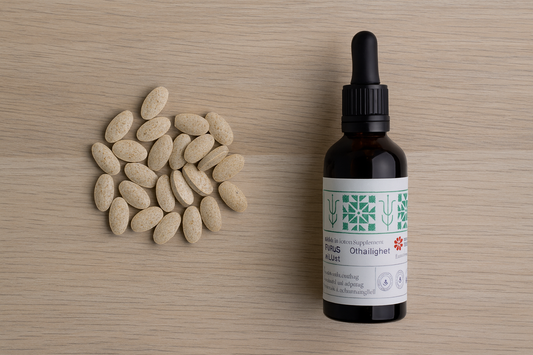Örtbloggen

NAD+ Hypen, sanningen och den naturliga vägen
Vad är NAD⁺? NAD⁺ (nikotinamidadenindinukleotid) är ett koenzym som finns i alla kroppens celler. Det spelar en central roll i energiomsättningen genom att hjälpa mitokondrierna att omvandla näring till energi....
NAD+ Hypen, sanningen och den naturliga vägen
Vad är NAD⁺? NAD⁺ (nikotinamidadenindinukleotid) är ett koenzym som finns i alla kroppens celler. Det spelar en central roll i energiomsättningen genom att hjälpa mitokondrierna att omvandla näring till energi....

Tre fantastiska örter för att sänka sitt koleterol
Att sänka kolesterolet är avgörande för att minska risken för hjärt-kärlsjukdomar. Förutom mediciner och livsstilsförändringar har vissa växter visat sig ha kolesterolsänkande egenskaper. I denna blogg fokuserar vi på tre...
Tre fantastiska örter för att sänka sitt koleterol
Att sänka kolesterolet är avgörande för att minska risken för hjärt-kärlsjukdomar. Förutom mediciner och livsstilsförändringar har vissa växter visat sig ha kolesterolsänkande egenskaper. I denna blogg fokuserar vi på tre...

Karvakrol, Thymol och manlig fertilitet – vad s...
Intresset för naturliga växter som kan påverka spermakvalitet och manliga könshormoner har ökat kraftigt de senaste åren. Två ämnen som fått mycket uppmärksamhet är karvakrol och thymol, de huvudsakliga bioaktiva...
Karvakrol, Thymol och manlig fertilitet – vad s...
Intresset för naturliga växter som kan påverka spermakvalitet och manliga könshormoner har ökat kraftigt de senaste åren. Två ämnen som fått mycket uppmärksamhet är karvakrol och thymol, de huvudsakliga bioaktiva...

Upptag i kroppen – tinktur vs piller
När vi pratar om örter och deras hälsofördelar finns det en avgörande fråga: hur mycket av växtens aktiva ämnen kan kroppen faktiskt ta upp och använda?
Upptag i kroppen – tinktur vs piller
När vi pratar om örter och deras hälsofördelar finns det en avgörande fråga: hur mycket av växtens aktiva ämnen kan kroppen faktiskt ta upp och använda?

Naturlig väg till bättre sexuell hälsa – Vinter...
Sexuell hälsa är avgörande för vårt välbefinnande. Upptäck hur Vinterkyndel (Satureja montana) kan stödja cirkulation, lust och naturlig sexuell funktion.
Naturlig väg till bättre sexuell hälsa – Vinter...
Sexuell hälsa är avgörande för vårt välbefinnande. Upptäck hur Vinterkyndel (Satureja montana) kan stödja cirkulation, lust och naturlig sexuell funktion.

Läkemedel mot förtidig utlösning vs Vinterkyndel
Dapoxetin vs. Vinterkyndel – två vägar till samma mål? För tidig utlösning (PE) är en av de vanligaste sexuella utmaningarna för män, och kan påverka både självförtroende och relationer. Inom...
Läkemedel mot förtidig utlösning vs Vinterkyndel
Dapoxetin vs. Vinterkyndel – två vägar till samma mål? För tidig utlösning (PE) är en av de vanligaste sexuella utmaningarna för män, och kan påverka både självförtroende och relationer. Inom...
